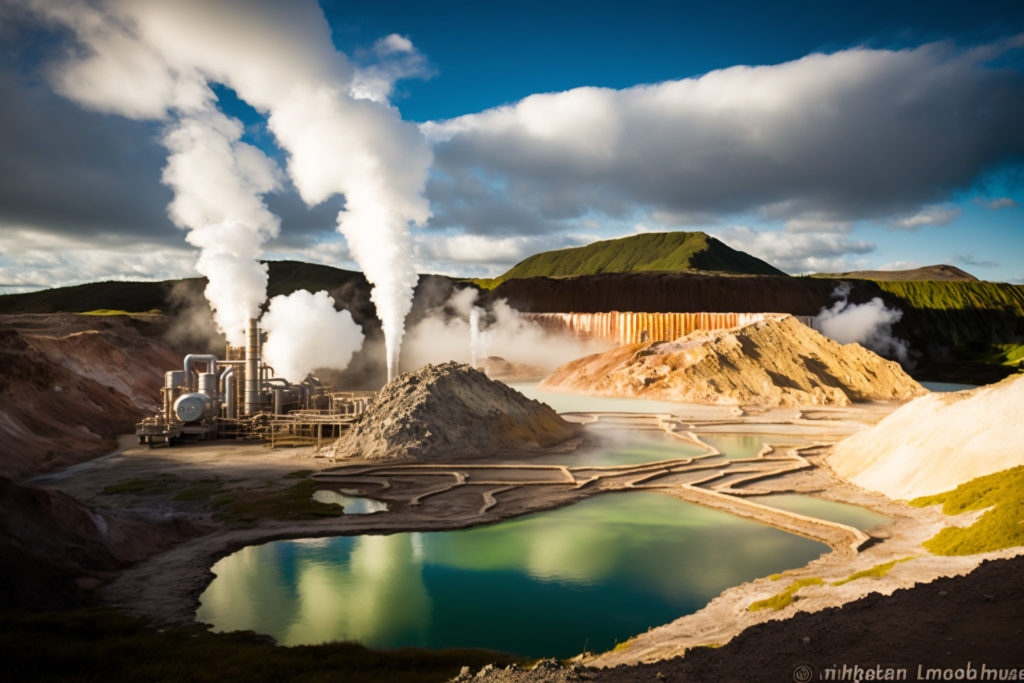I. Introduction – Defining Geothermal Energy, Power and Heating
A. Definition of Geothermal Energy
Geothermal energy is the heat energy generated and stored in the Earth, which can be accessed and used for various domestic and industrial purposes. It is a renewable energy source which is both clean and abundant and can be used to produce electricity and to heat and cool buildings. Geothermal energy is produced in the form of hot water or steam that is extracted from underground reservoirs and piped to the surface. This steam can then be used to drive turbines, which generate electricity. It can also be used directly to provide heating and cooling for buildings.
B. Overview of Geothermal Power and Heating Options
Geothermal power plants can generate electricity using several different types of technology. Direct use geothermal systems, such as ground source heat pumps, use heated water from underground reservoirs to provide direct heating or cooling for buildings. The energy from the heated water can also be used to generate electricity in power plants. Binary cycle power plants use steam from underground reservoirs to drive turbines, which generate electricity. These plants are often used in areas where the temperature of the steam is not hot enough to drive the turbines. Enhanced geothermal systems (EGS) use hot water that is injected into the earth to create fractures in the rock, which allows hot water to flow freely and be used to generate electricity.
EGS can be used in areas where conventional geothermal sources are not available. Geothermal heating systems use the earth’s natural heat to provide heating, cooling, and hot water to buildings. These systems use a heat pump to move the heat from the earth into the building, and a ground loop to transfer the heat between the building and the earth. Ground source heat pumps are the most efficient type of geothermal heating system.
II. Benefits and Advantages of Geothermal Energy
Geothermal energy is a renewable energy source that has been used since ancient times, and is still a viable energy source today. Geothermal energy has a wide range of benefits, including cost effectiveness, environmental benefits, versatility, and energy efficiency. This section will explore the benefits and advantages of geothermal energy in more detail.
A. Cost Effectiveness
Geothermal energy is cost-effective because it requires minimal operating costs and does not rely on fossil fuels for energy production. Geothermal systems can save up to 70 percent on heating costs, and in some areas, such as Iceland, geothermal power plants are the cheapest energy source available. Additionally, geothermal energy systems require minimal maintenance, making them a reliable and cost effective energy solution.
B. Environmental Benefits
Geothermal energy is an environmentally friendly energy source that does not produce any air pollution or greenhouse gas emissions. Unlike fossil fuels, which are the main source of air pollution and contribute to global warming, geothermal energy does not release any emissions into the atmosphere. Additionally, geothermal energy does not require additional water for cooling, which is often the case with other energy sources. This makes geothermal energy a sustainable and environmentally friendly energy source.
C. Versatility
Geothermal energy is a versatile energy source that can be used to power homes, businesses, and even entire communities. Geothermal energy can be used to generate electricity, heat homes, and provide hot water. Additionally, geothermal energy can be used to power industrial processes, such as mining and manufacturing. This makes geothermal energy a versatile and reliable energy source that can be used in a variety of applications.
D. Energy Efficiency
Finally, geothermal energy is highly energy efficient. Since geothermal energy is generated from the Earth’s heat, it does not require additional energy to produce electricity. Additionally, geothermal systems are more efficient than traditional heating and cooling systems, as they do not need to be turned on and off in order to maintain a desired temperature. This makes geothermal energy a highly efficient and reliable energy source.
III. Challenges of Geothermal Energy
The use of geothermal energy for power and heating is not without its challenges, which must be considered before attempting to move forward with a geothermal project. These challenges can be both environmental and practical.
A. Geographical Limitations
Geographical Limitations – Geothermal power or heating systems only work in areas with high concentrations of geothermal activity. This means that the geography of an area can be a limiting factor in terms of geothermal energy exploration. Geothermal power plants must be built on or near existing geological faults or geological formations that allow for the direct extraction of hot water or steam from the Earth. Areas that are popular for geothermal include the US, Iceland, Russia and Canada.
B. Performance Issues
Performance Issues – Geothermal energy systems can suffer from performance issues due to a variety of factors. For example, the temperature of the water or steam below the Earth’s surface can vary, resulting in inconsistent output from the system. In addition, the amount of energy that can be extracted from the Earth is limited. This means that geothermal resources must be managed carefully in order to ensure that they are not depleted.
C. Operational Expenses
Finally, geothermal energy systems can be expensive to install and maintain, and require a significant amount of upfront capital to get started. This can be especially true for geothermal power plants, which require significant amounts of both time and money to get up and running.
For these reasons, it is important to weigh the potential benefits and costs of geothermal energy carefully before attempting to move forward with a project. Only by doing so can one ensure that the benefits of geothermal energy outweigh the potential risks and costs associated with it.

IV. Real-World Examples of Geothermal Energy
Geothermal energy is increasingly being used for both power generation and heating. There are a variety of real-world examples of geothermal energy in action today.
A. Geothermal Power Plant Examples
Geothermal power plants are being built around the world. Examples of geothermal power plants include the Hengill geothermal power plant in Iceland and the Geysers geothermal power plant in California. The Hengill geothermal power plant generates up to 300 megawatts of electricity, while the Geysers geothermal power plant generates up to 725 megawatts of electricity.
The Hellisheidi geothermal power plant in Iceland is the world’s largest geothermal power plant, with a capacity of up to 303 megawatts. The plant has been in operation since 2006 and provides electricity to over 150,000 homes.
B. Geothermal Heating Systems in Homes
Geothermal heating systems are becoming more popular in homes. Such systems use the constant temperature of the earth to heat and cool homes. The ground loops used in geothermal systems are often buried several feet below the ground, where the temperature is constant throughout the year.
The cost of installing a geothermal system in a home is usually higher than a traditional HVAC system, but the long-term energy savings make it a cost-effective choice. In addition, geothermal heating and cooling systems have the potential to improve energy efficiency by up to 70%.
Geothermal Power Plant Examples
Geothermal Heating Systems in Homes
V. Conclusion
The future of geothermal energy is looking bright, with the potential to unlock vast amounts of clean, renewable energy that can be used to meet both residential and industrial needs. Efforts are being taken to maximize the potential of geothermal energy and overcome the challenges that remain. With the advancement of technology and implementation of new strategies, geothermal energy is anticipated to become a larger part of the global energy mix.
Long-term, geothermal energy can help reduce emissions, promote energy independence and stimulate economic growth. As the world looks to address the climate crisis, geothermal energy should be part of the solution in order to drive energy efficiency, reduce energy costs and increase the reliability of energy systems. Geothermal energy could provide a reliable source of electricity and heating while decarbonizing energy systems. With the right investments and policies in place, geothermal energy can become a key source of clean energy in the future.
As you explore the exciting world of Geothermal Energy, Geothermal Power, Geothermal Heating, and Geothermal Energy Efficiency, we would like to draw your attention to some of our other related reports. These reports will provide a deeper understanding of the industries related to Geothermal Energy and their impact on the world. Take a look at the following articles to learn more:
- Investing in Infrastructure: Opportunities and Challenges
- Sustainable Manufacturing: Link between Environmental Factors and Prosperity
- Impact of Government Regulations on the Pharmaceutical Industry
- The Future of the Oil and Gas Industry: Exploration and Production
- Sustainable Forestry Market Report and Forest Management Guide
- Unlocking the Potential of Drones: A Comprehensive Industry Report
We are confident that these reports will provide valuable insights and information, and enhance your overall knowledge on the related industries. Happy reading!











